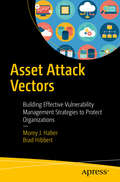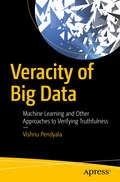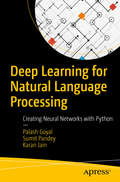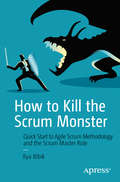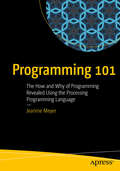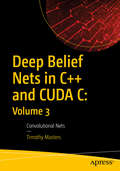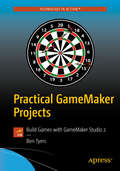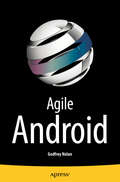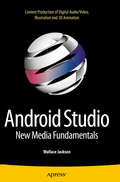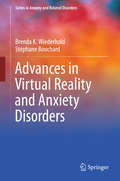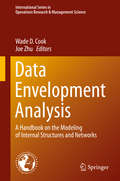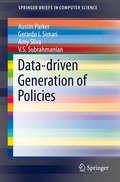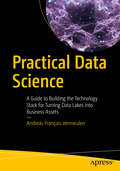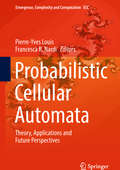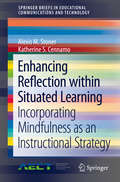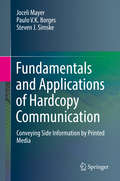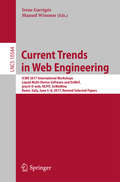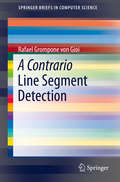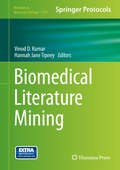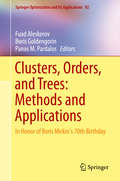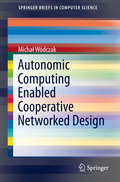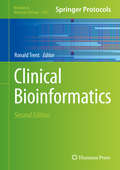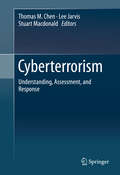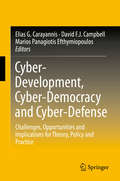- Table View
- List View
Asset Attack Vectors: Building Effective Vulnerability Management Strategies to Protect Organizations
by Morey J. Haber Brad HibbertBuild an effective vulnerability management strategy to protect your organization’s assets, applications, and data.Today’s network environments are dynamic, requiring multiple defenses to mitigate vulnerabilities and stop data breaches. In the modern enterprise, everything connected to the network is a target. Attack surfaces are rapidly expanding to include not only traditional servers and desktops, but also routers, printers, cameras, and other IOT devices. It doesn’t matter whether an organization uses LAN, WAN, wireless, or even a modern PAN—savvy criminals have more potential entry points than ever before. To stay ahead of these threats, IT and security leaders must be aware of exposures and understand their potential impact. Asset Attack Vectors will help you build a vulnerability management program designed to work in the modern threat environment. Drawing on years of combined experience, the authors detail the latest techniques for threat analysis, risk measurement, and regulatory reporting. They also outline practical service level agreements (SLAs) for vulnerability management and patch management. Vulnerability management needs to be more than a compliance check box; it should be the foundation of your organization’s cybersecurity strategy. Read Asset Attack Vectors to get ahead of threats and protect your organization with an effective asset protection strategy. What You’ll Learn Create comprehensive assessment and risk identification policies and procedures Implement a complete vulnerability management workflow in nine easy steps Understand the implications of active, dormant, and carrier vulnerability states Develop, deploy, and maintain custom and commercial vulnerability management programs Discover the best strategies for vulnerability remediation, mitigation, and removal Automate credentialed scans that leverage least-privilege access principles Read real-world case studies that share successful strategies and reveal potential pitfalls Who This Book Is For New and intermediate security management professionals, auditors, and information technology staff looking to build an effective vulnerability management program and defend against asset based cyberattacks
Veracity of Big Data: Machine Learning and Other Approaches to Verifying Truthfulness
by Vishnu PendyalaExamine the problem of maintaining the quality of big data and discover novel solutions. You will learn the four V’s of big data, including veracity, and study the problem from various angles. The solutions discussed are drawn from diverse areas of engineering and math, including machine learning, statistics, formal methods, and the Blockchain technology. Veracity of Big Data serves as an introduction to machine learning algorithms and diverse techniques such as the Kalman filter, SPRT, CUSUM, fuzzy logic, and Blockchain, showing how they can be used to solve problems in the veracity domain. Using examples, the math behind the techniques is explained in easy-to-understand language.Determining the truth of big data in real-world applications involves using various tools to analyze the available information. This book delves into some of the techniques that can be used. Microblogging websites such as Twitter have played a major role in public life, including during presidential elections. The book uses examples of microblogs posted on a particular topic to demonstrate how veracity can be examined and established. Some of the techniques are described in the context of detecting veiled attacks on microblogging websites to influence public opinion.What You'll LearnUnderstand the problem concerning data veracity and its ramificationsDevelop the mathematical foundation needed to help minimize the impact of the problem using easy-to-understand language and examplesUse diverse tools and techniques such as machine learning algorithms, Blockchain, and the Kalman filter to address veracity issuesWho This Book Is ForSoftware developers and practitioners, practicing engineers, curious managers, graduate students, and research scholars
Deep Learning for Natural Language Processing: Creating Neural Networks with Python
by Palash Goyal Sumit Pandey Karan JainDiscover the concepts of deep learning used for natural language processing (NLP), with full-fledged examples of neural network models such as recurrent neural networks, long short-term memory networks, and sequence-2-sequence models.You’ll start by covering the mathematical prerequisites and the fundamentals of deep learning and NLP with practical examples. The first three chapters of the book cover the basics of NLP, starting with word-vector representation before moving onto advanced algorithms. The final chapters focus entirely on implementation, and deal with sophisticated architectures such as RNN, LSTM, and Seq2seq, using Python tools: TensorFlow, and Keras. Deep Learning for Natural Language Processing follows a progressive approach and combines all the knowledge you have gained to build a question-answer chatbot system.This book is a good starting point for people who want to get started in deep learning for NLP. All the code presented in the book will be available in the form of IPython notebooks and scripts, which allow you to try out the examples and extend them in interesting ways.What You Will LearnGain the fundamentals of deep learning and its mathematical prerequisitesDiscover deep learning frameworks in Python Develop a chatbot Implement a research paper on sentiment classificationWho This Book Is ForSoftware developers who are curious to try out deep learning with NLP.
How to Kill the Scrum Monster: Quick Start to Agile Scrum Methodology and the Scrum Master Role
by Ilya BibikImplement Scrum or improve how Scrum works in your team or organization using this concise, sharp, and programmatic book. You will quickly learn what you need to know without getting confused with unnecessary details.What You'll LearnBecome familiar with Agile concepts and understand the path from Waterfall to the Agile ManifestoUnderstand the most commonly used Agile methodology—Scrum—and how it relates to eXtreme Programming and Kanban as well as to Lean principlesIdentify the challenges of the Scrum Master role and understand what this role is all aboutKnow the stages of Scrum team developmentEmbrace and solve conflicts in a Scrum teamWho This Book Is ForAnyone looking for a simple way to understand Scrum methodology
Programming 101: The How and Why of Programming Revealed Using the Processing Programming Language
by Jeanine MeyerUnderstand the importance of programming, even if you’ve never programmed before! This book will teach you the basics of programming using the Processing programming language. You will create your own Processing sketches, using personal images, themes, or hobbies that you enjoy. The chapters in the book will demonstrate the process of programming, starting with formulating an idea, planning, building on past projects, and refining the work, similar to writing an essay or composing a song. This approach will guide you to make use of logic and mathematics to produce beautiful effects.The term for program in Processing is sketch, though the sketches featured in this book are far more than static drawings; they incorporate interaction, animation, video, audio, and accessing files on the local computer and on the Web. Technical features are introduced and explained in the context of complete examples: games (Snake, Hangman, jigsaw, slingshot), making a collage of family images and video clips, preparing directions for folding an origami model, rotating objects in 3D, and others.Programming is a fun, creative, expressive pursuit. It requires attention to details and can be frustrating, but there is very little that compares to the satisfaction of building a program out of nothing and making it work (or taking an existing program and fixing a problem, or adding a feature and making it better). Programming 101 is your gateway to making this happen. What You Will Learn Gain basic programming skillsBuild fun and creative programsUse files for making a holiday cardCombine videos, images, and graphics in a Processing sketch Who This Book Is For Anyone who has been thinking about trying programming, or has tried, but needs more motivation; anyone who wants to learn about the Processing language.
Deep Belief Nets in C++ and CUDA C: Convolutional Nets
by Timothy MastersDiscover the essential building blocks of a common and powerful form of deep belief network: convolutional nets. This book shows you how the structure of these elegant models is much closer to that of human brains than traditional neural networks; they have a ‘thought process’ that is capable of learning abstract concepts built from simpler primitives. These models are especially useful for image processing applications. At each step Deep Belief Nets in C++ and CUDA C: Volume 3 presents intuitive motivation, a summary of the most important equations relevant to the topic, and concludes with highly commented code for threaded computation on modern CPUs as well as massive parallel processing on computers with CUDA-capable video display cards. Source code for all routines presented in the book, and the executable CONVNET program which implements these algorithms, are available for free download.What You Will LearnDiscover convolutional nets and how to use themBuild deep feedforward nets using locally connected layers, pooling layers, and softmax outputsMaster the various programming algorithms requiredCarry out multi-threaded gradient computations and memory allocations for this threadingWork with CUDA code implementations of all core computations, including layer activations and gradient calculationsMake use of the CONVNET program and manual to explore convolutional nets and case studiesWho This Book Is ForThose who have at least a basic knowledge of neural networks and some prior programming experience, although some C++ and CUDA C is recommended.
Practical GameMaker Projects: Build Games with GameMaker Studio 2
by Ben TyersMake ten simple, casual games, and learn a ton of GML coding along the way. Each of these games is the kind you can play when you have a minute or two free, and are great for playing on your PC, or exported to HTML5 or Android.Each game in Practical GameMaker Projects has its own chapter that explains the process of making each game, along with sketches, screenshots, coding, explanations, and tips. For each game there is a YYZ project file of the completed game that is ready to load and play. Also, all resources are available so you can make the game as you follow along in the book.Each chapter has an introduction that explains what the aim of the game is, followed by a design and coding section which will cover the coding of the game. You’re free to re-use code in your own projects, both free and paid. At the end of each chapter there is a things-to-try page that gives you five things to add to the game to improve its playability or appearance – pushing you a little to improve your planning and GML skills. What You'll LearnBuild ten game applications using GameMaker Studio 2Use the GameMaker Markup Language along the wayMaster the concepts behind each of the ten game apps Design and code for each of the ten game examplesTry some add-ons for each of the ten gamesWho This Book Is ForGame developers with at least some prior game development experience. GameMaker Studio experience recommended, but not required.
Agile Android
by Godfrey NolanThis concise book walks you through how to get unit testing and test driven development done on Android, specifically using JUnit 4. You'll learn how to do agile development quickly and correctly, with a significant increase in development efficiency and a reduction in the number of defects. Up until now getting JUnit testing up and running in Android was not for the faint hearted. However, "now it's in Android Studio, there is no excuse," according to author Godfrey Nolan, president of RIIS LLC. Android developers are faced with their own set of problems such as tightly coupled code, fragmentation, and immature testing tools, all of which can be solved using existing agile tools and techniques that this short book will teach you. What you'll learn What is the Agile testing pyramid for Android What are the Android unit testing tools and how to use them, including those found in Android Studio What are and how to use third party tools like JUnit, Hamcrest, Roboletric, Jenkins and more What is and how to use mocking, including mocking frameworks like Mockito to mock out Web Services, Shared Preferences and SQLite databases How to do test driven development (TDD) in Android How to manage legacy code and applying TDD to existing projects Who this book is for Android developers and IT managers. Healthcare, financial, entertainment and government. Senior developers, software architects, lead developer, IT directors, CTOs, CISOs. Table of Contents Lesson 1: Introduction to Agile Learning objectives 1. 1 Understand the benefits of using an Agile approach to Android development 1. 2 Understand common defects in Android Applications 1. 3 Explore the Agile Testing Pyramid for Android Lesson 2: Android Unit Testing Tools Learning objectives 2. 1 Create Hello World Unit Test in Android 2. 2 Run Unit Tests from the command line 2. 3 Explore Android Assertions 2. 4 Test for common defects in Android Applications 2. 5 Setup and Teardown 2. 6 Grouping tests 2. 7 Adding unit tests to a Twitter client 2. 8 Explore more Android Assertions 2. 9 Run your tests using Gradle Lesson 3: Third Party Tools Learning objectives 3. 1: Understand the difference between jUnit3 and jUnit4 3. 2: Create jUnit4 Unit Test in Android Studio 3. 3: Run code coverage tools in Android 3. 4: Test activities on multiple devices using Spoon 3. 5: Create an Android project in Github Lesson 4: Mocking Learning objectives 4. 1 Stubs vs test double vs mocking frameworks 4. 2 Using a stub to mock out a SQLite database 4. 3 Using a test double to mock out a SQLite database 4. 4 Using EasyMock to mock out a SQLite database Lesson 5: Dependency Injection Learning objectives 5. 1 Understanding Compile Time Dependency Injection 5. 2 Create an Android unit test using Dagger 5. 3 Using Dagger to mock a SQLite databases Lesson 7: Test Driven Development Learning objectives 7. 1 Understanding Test Driven Development 7. 2 Writing Testable Code 7. 3 Refactoring code 7. 4 Writing a Twitter client using TDD Lesson 8: Dealing with Legacy Code Learning objectives 8. 1 Applying TDD to an Existing Project 8. 2 Ring Fence Existing Project 8. 3 Refactoring Existing Code to increase Code Coverage
Android Studio New Media Fundamentals: Content Production of Digital Audio/Video, Illustration and 3D Animation
by Wallace JacksonAndroid Studio New Media Fundamentals is a new media primer covering concepts central to multimedia production for Android including digital imagery, digital audio, digital video, digital illustration and 3D, using open source software packages such as GIMP, Audacity, Blender, and Inkscape. These professional software packages are used for this book because they are free for commercial use. The book builds on the foundational concepts of raster, vector, and waveform (audio), and gets more advanced as chapters progress, covering what new media assets are best for use with Android Studio as well as key factors regarding the data footprint optimization work process and why new media content and new media data optimization is so important. What you'll learn What are the primary genres of new media content production What new media asset types Android Studio currently supports What are the concepts and terms behind new media content production How to accomplish data footprint optimization for each new media asset type How to install and configure GIMP, Inkscape, Lightworks, Blender, and Audacity How to integrate new media content assets with Android Studio, the most popular IDE for Android design and development Who this book is for Primary audience includes Android developers, especially game designers/developers and others who need access to multimedia elements. Secondary: multimedia producers, RIA developers, game designers, UI designers, and teachers. Table of Contents 1. Enhance Your Android Apps: Use New Media Assets 2. Digital Images: Concepts, Terminology and Formats 3. Digital Image Assets: Data Footprint Optimization 4. Digital Audio: Concepts, Terminology and Formats 5. Digital Audio Assets: Data Footprint Optimization 6. Digital Video: Concepts, Terminology and Formats 7. Digital Video Assets: Data Footprint Optimization 8. Digital Illustration: Concepts, Terminology and Formats 9. Digital Illustration Assets: Data Footprint Optimization 10. 3D Animation: Concepts, Terminology and Formats 11. Referencing New Media Assets in Android Studio 12. Optimizing New Media Assets in Android Studio
Advances in Virtual Reality and Anxiety Disorders (Series in Anxiety and Related Disorders)
by Brenda K. Wiederhold Stéphane BouchardThe interactive computer-generated world of virtual reality has been successful in treating phobias and other anxiety-related conditions, in part because of its distinct advantages over traditional in vivo exposure. Yet many clinicians still think of VR technology as it was in the 1990s-bulky, costly, technically difficult-with little knowledge of its evolution toward more modern, evidence-based, practice-friendly treatment. These updates, and their clinical usefulness, are the subject of Advances in Virtual Reality and Anxiety Disorders, a timely guidebook geared toward integrating up-to-date VR methods into everyday practice. Introductory material covers key virtual reality concepts, provides a brief history of VR as used in therapy for anxiety disorders, addresses the concept of presence, and explains the side effects, known as cybersickness, that affect a small percentage of clients. Chapters in the book's main section detail current techniques and review study findings for using VR in the treatment of: · Claustrophobia. · Panic disorder, agoraphobia, and driving phobia. · Acrophobia and aviophobia. · Arachnophobia. · Social phobia. · Generalized anxiety disorder and OCD. · PTSD. · Plus clinical guidelines for establishing a VR clinic. An in-depth framework for effective (and cost-effective) therapeutic innovations for entrenched problems, Advances in Virtual Reality and Anxiety Disorders will find an engaged audience among psychologists, psychiatrists, social workers, and mental health counselors. eractive
Data Envelopment Analysis: A Handbook of Modeling Internal Structure and Network (International Series in Operations Research & Management Science #208)
by Joe Zhu Wade D. CookThis handbook serves as a complement to the Handbook on Data Envelopment Analysis (eds, W. W. Cooper, L. M. Seiford and J, Zhu, 2011, Springer) in an effort to extend the frontier of DEA research. It provides a comprehensive source for the state-of-the art DEA modeling on internal structures and network DEA. Chapter 1 provides a survey on two-stage network performance decomposition and modeling techniques. Chapter 2 discusses the pitfalls in network DEA modeling. Chapter 3 discusses efficiency decompositions in network DEA under three types of structures, namely series, parallel and dynamic. Chapter 4 studies the determination of the network DEA frontier. In chapter 5 additive efficiency decomposition in network DEA is discussed. An approach in scale efficiency measurement in two-stage networks is presented in chapter 6. Chapter 7 further discusses the scale efficiency decomposition in two stage networks. Chapter 8 offers a bargaining game approach to modeling two-stage networks. Chapter 9 studies shared resources and efficiency decomposition in two-stage networks. Chapter 10 introduces an approach to computing the technical efficiency scores for a dynamic production network and its sub-processes. Chapter 11 presents a slacks-based network DEA. Chapter 12 discusses a DEA modeling technique for a two-stage network process where the inputs of the second stage include both the outputs from the first stage and additional inputs to the second stage. Chapter 13 presents an efficiency measurement methodology for multi-stage production systems. Chapter 14 discusses network DEA models, both static and dynamic. The discussion also explores various useful objective functions that can be applied to the models to find the optimal allocation of resources for processes within the black box, that are normally invisible to DEA. Chapter 15 provides a comprehensive review of various type network DEA modeling techniques. Chapter 16 presents shared resources models for deriving aggregate measures of bank-branch performance, with accompanying component measures that make up that aggregate value. Chapter 17 examines a set of manufacturing plants operating under a single umbrella, with the objective being to use the component or function measures to decide what might be considered as each plant's core business. Chapter 18 considers problem settings where there may be clusters or groups of DMUs that form a hierarchy. The specific case of a set off electric power plants is examined in this context. Chapter 19 models bad outputs in two-stage network DEA. Chapter 20 presents an application of network DEA to performance measurement of Major League Baseball (MLB) teams. Chapter 21 presents an application of a two-stage network DEA model for examining the performance of 30 U. S. airline companies. Chapter 22 then presents two distinct network efficiency models that are applied to engineering systems.
Data-driven Generation of Policies (SpringerBriefs in Computer Science)
by Amy Sliva V. S. Subrahmanian Austin Parker Gerardo I. SimariThis Springer Brief presents a basic algorithm that provides a correct solution to finding an optimal state change attempt, as well as an enhanced algorithm that is built on top of the well-known trie data structure. It explores correctness and algorithmic complexity results for both algorithms and experiments comparing their performance on both real-world and synthetic data. Topics addressed include optimal state change attempts, state change effectiveness, different kind of effect estimators, planning under uncertainty and experimental evaluation. These topics will help researchers analyze tabular data, even if the data contains states (of the world) and events (taken by an agent) whose effects are not well understood. Event DBs are omnipresent in the social sciences and may include diverse scenarios from political events and the state of a country to education-related actions and their effects on a school system. With a wide range of applications in computer science and the social sciences, the information in this Springer Brief is valuable for professionals and researchers dealing with tabular data, artificial intelligence and data mining. The applications are also useful for advanced-level students of computer science.
Practical Data Science
by Andreas François VermeulenLearn how to build a data science technology stack and perform good data science with repeatable methods. You will learn how to turn data lakes into business assets.The data science technology stack demonstrated in Practical Data Science is built from components in general use in the industry. Data scientist Andreas Vermeulen demonstrates in detail how to build and provision a technology stack to yield repeatable results. He shows you how to apply practical methods to extract actionable business knowledge from data lakes consisting of data from a polyglot of data types and dimensions.What You'll LearnBecome fluent in the essential concepts and terminology of data science and data engineering Build and use a technology stack that meets industry criteriaMaster the methods for retrieving actionable business knowledgeCoordinate the handling of polyglot data types in a data lake for repeatable resultsWho This Book Is ForData scientists and data engineers who are required to convert data from a data lake into actionable knowledge for their business, and students who aspire to be data scientists and data engineers
Probabilistic Cellular Automata: Theory, Applications And Future Perspectives (Emergence, Complexity And Computation Ser. #27)
by Pierre-Yves Louis Francesca R. NardiThis book explores Probabilistic Cellular Automata (PCA) from the perspectives of statistical mechanics, probability theory, computational biology and computer science. PCA are extensions of the well-known Cellular Automata models of complex systems, characterized by random updating rules. Thanks to their probabilistic component, PCA offer flexible computing tools for complex numerical constructions, and realistic simulation tools for phenomena driven by interactions among a large number of neighboring structures. PCA are currently being used in various fields, ranging from pure probability to the social sciences and including a wealth of scientific and technological applications. This situation has produced a highly diversified pool of theoreticians, developers and practitioners whose interaction is highly desirable but can be hampered by differences in jargon and focus. This book – just as the workshop on which it is based – is an attempt to overcome these difference and foster interest among newcomers and interaction between practitioners from different fields. It is not intended as a treatise, but rather as a gentle introduction to the role and relevance of PCA technology, illustrated with a number of applications in probability, statistical mechanics, computer science, the natural sciences and dynamical systems. As such, it will be of interest to students and non-specialists looking to enter the field and to explore its challenges and open issues.
Enhancing Reflection within Situated Learning: Incorporating Mindfulness As An Instructional Strategy (Springerbriefs In Educational Communications And Technology Ser.)
by Alexis M. Stoner Katherine S. CennamoThis innovative brief provides guidance on promoting reflection in situated learning by incorporating mindfulness strategies, tapping into a surge of research interest in exploring mindfulness as an instructional strategy associated with positive learning outcomes. It illustrates the benefits of continuous reflection within situated learning and how mindfulness can be incorporated before, during, and after the learning experience to enhance the reflective experience. Critically, the authors present a new conceptual model that synthesizes theories and methods from three different areas of study—mindfulness, situated learning, and reflection— to provide a new perspective and instructional approach that has great potential to positively impact outcomes in situated learning.Among the other topics covered:• Strategies for reflection in situated learning.• Strategies for reflection-in-action in situated learning.• Mindfulness strategies for situated learning.• A conceptual model incorporating mindfulness to enhance reflection.Enhancing Reflection within Situated Learning is an exciting and pioneering resource that offers practical guidance to educators and instructional designers interested in incorporating methods and approaches for integrating mindfulness and reflection across instructional environments.
Contemporary Research and Perspectives on Early Childhood Mathematics Education (ICME-13 Monographs)
by Christiane Benz Ann Anderson Anna Baccaglini-Frank Iliada Elia Joanne MulliganThis book brings together a collection of research-based papers on current issues in early childhood mathematics education that were presented in the Topic Study Group 1 (TSG 1) at the 13th International Congress on Mathematical Education (ICME-13), held at the University of Hamburg in 2016. It will help readers understand a range of key issues that early childhood mathematics educators encounter today. Research on early childhood mathematics education has grown in recent years, due in part to the well-documented, positive relation between children’s early mathematical knowledge and their later mathematics learning, and to the considerable emphasis many countries are now placing on preschool education. The book addresses a number of central questions, including: What is mathematical structural development and how can we promote it in early childhood? How can multimodality and embodiment contribute to early mathematics learning and to acquiring a better understanding of young children’s mathematical development? How can children’s informal mathematics-related experiences affect instruction and children’s learning in different mathematics content areas? What is the role of tools, including technology and picture books, in supporting early mathematics learning? What are the challenges in early childhood mathematics education for teachers’ education and professional development?
Fundamentals and Applications of Hardcopy Communication: Conveying Side Information By Printed Media
by Steven J. Simske Joceli Mayer Paulo V.K. BorgesThis book presents covert, semi-covert and overt techniques for communication over printed media by modifying images, texts or barcodes within the document. Basic and advanced techniques are discussed aimed to modulate information into images, texts and barcodes.Conveying information over printed media can be useful for content authentication, author copyright, information and piracy product deterrent, side information for marketing, among other applications. Practical issues are discussed and experiments are provided to evaluate competitive approaches for hard-copy communication.This book is a useful resource for researchers, practitioners and graduate students in the field of hard-copy communication by providing the fundamentals, basic and advanced techniques as examples of approaches to address the hard-copy media distortions and particularities.
Current Trends in Web Engineering: Icwe 2012 International Workshops Mdwe, Composableweb, Were, Qwe, And Doctoral Consortium, Berlin, Germany, July 2012, Revised Selected Papers (Lecture Notes In Computer Science / Information Systems And Applications, Incl. Internet/web, And Hci Ser. #7703)
by Manuel Wimmer Irene GarrigósThis book constitutes the refereed thoroughly refereed post-workshop proceedings of the 17th International Conference on Web Engineering, ICWE 2017, held in Rome, Italy, in June 2017.The 24 revised full papers were selected from 34 submissions. The workshops complement the main conference, and explore new trends on core topics of Web engineering. The workshop committee accepted five workshops of which the following four contributed papers to this volume: - 2nd International Workshop on Liquid Multi-Device Software and 1st International Workshop on Engineering the Web of Things - International Workshop on The Practice Of The Open Web (practi-O-web 2017) - 3rd International Workshop on Natural Language Processing for Informal Text (NLPIT 2017)- 3rd International Workshop on Mining the Social Web (SoWeMine 2017).
A Contrario Line Segment Detection (SpringerBriefs in Computer Science)
by Rafael Grompone von GioiThe reliable detection of low-level image structures is an old and still challenging problem in computer vision. This book leads a detailed tour through the LSD algorithm, a line segment detector designed to be fully automatic. Based on the a contrario framework, the algorithm works efficiently without the need of any parameter tuning. The design criteria are thoroughly explained and the algorithm's good and bad results are illustrated on real and synthetic images. The issues involved, as well as the strategies used, are common to many geometrical structure detection problems and some possible extensions are discussed.
Biomedical Literature Mining (Methods in Molecular Biology #1159)
by Vinod D. Kumar Hannah Jane TipneyBiomedical Literature Mining, discusses the multiple facets of modern biomedical literature mining and its many applications in genomics and systems biology. The volume is divided into three sections focusing on information retrieval, integrated text-mining approaches and domain-specific mining methods. Written in the highly successful Methods in Molecular Biology series format, chapters include introductions to their respective topics, lists of the necessary materials and reagents, step-by-step, readily reproducible laboratory protocols and key tips on troubleshooting and avoiding known pitfalls. Authoritative and practical, Biomedical Literature Mining is designed as a useful bioinformatics resource in biomedical literature text mining for both those long experienced in or entirely new to, the field.
Clusters, Orders, and Trees: In Honor of Boris Mirkin's 70th Birthday (Springer Optimization and Its Applications #92)
by Panos M. Pardalos Boris Goldengorin Fuad AleskerovThe volume is dedicated to Boris Mirkin on the occasion of his 70th birthday. In addition to his startling PhD results in abstract automata theory, Mirkin's ground breaking contributions in various fields of decision making and data analysis have marked the fourth quarter of the 20th century and beyond Mirkin has done pioneering work in group choice, clustering, data mining and knowledge discovery aimed at finding and describing non-trivial or hidden structures--first of all, clusters, orderings and hierarchies--in multivariate and/or network data. This volume contains a collection of papers reflecting recent developments rooted in Mirkin's fundamental contribution to the state-of-the-art in group choice, ordering, clustering, data mining and knowledge discovery. Researchers, students and software engineers will benefit from new knowledge discovery techniques and application directions.
Autonomic Computing Enabled Cooperative Networked Design (SpringerBriefs in Computer Science)
by Michał WódczakThis book introduces the concept of autonomic computing driven cooperative networked system design from an architectural perspective. As such it leverages and capitalises on the relevant advancements in both the realms of autonomic computing and networking by welding them closely together. In particular, a multi-faceted Autonomic Cooperative System Architectural Model is defined which incorporates the notion of Autonomic Cooperative Behaviour being orchestrated by the Autonomic Cooperative Networking Protocol of a cross-layer nature. The overall proposed solution not only advocates for the inclusion of certain Decision Making Entities, but it also provides all the necessary implementation guidelines along with the pertinent standardisation orientated insight.
Clinical Bioinformatics (Methods in Molecular Biology #1168)
by Ronald TrentIn Clinical Bioinformatics, Second Edition, leading experts in the field provide a series of articles focusing on software applications used to translate information into outcomes of clinical relevance. Recent developments in omics, such as increasingly sophisticated analytic platforms allowing changes in diagnostic strategies from the traditional focus on single or small number of analytes to what might be possible when large numbers or all analytes are measured, are now impacting patient care. Covering such topics as gene discovery, gene function (microarrays), DNA sequencing, online approaches and resources, and informatics in clinical practice, this volume concisely yet thoroughly explores this cutting-edge subject Written in the successful Methods in Molecular Biology series format, chapters include introductions to their respective topics, lists of the necessary materials and reagents, step-by-step, readily reproducible protocols, and notes on troubleshooting and avoiding known pitfalls. Authoritative and easily accessible, Clinical Bioinformatics, Second Edition serves as an ideal guide for scientists and health professionals working in genetics and genomics.
Cyberterrorism: Understanding, Assessment, and Response
by Thomas M. Chen Lee Jarvis Stuart MacdonaldThis is the first book to present a multidisciplinary approach to cyberterrorism It traces the threat posed by cyberterrorism today, with chapters discussing possible technological vulnerabilities, potential motivations to engage in cyberterrorism, and the challenges of distinguishing this from other cyber threats. The book also addresses the range of potential responses to this threat by exploring policy and legislative frameworks as well as a diversity of techniques for deterring or countering terrorism in cyber environments. The case studies throughout the book are global in scope and include the United States, United Kingdom, Australia, New Zealand and Canada. With contributions from distinguished experts with backgrounds including international relations, law, engineering, computer science, public policy and politics, Cyberterrorism: Understanding, Assessment and Response offers a cutting edge analysis of contemporary debate on, and issues surrounding, cyberterrorism. This global scope and diversity of perspectives ensure it is of great interest to academics, students, practitioners, policymakers and other stakeholders with an interest in cyber security.
Cyber-Development, Cyber-Democracy and Cyber-Defense: Challenges, Opportunities and Implications for Theory, Policy and Practice
by Elias G. Carayannis David F. J. Campbell Marios Panagiotis EfthymiopoulosIn this volume, contributors from academia, industry, and policy explore the inter-connections among economic development, socio-political democracy and defense and security in the context of a profound transformation, spurred by globalization and supported by the rapid development of information and communication technologies (ICT). This powerful combination of forces is changing the way we live and redefining the way companies conduct business and national governments pursue strategies of innovation, economic growth and diplomacy. Integrating theoretical frameworks, empirical research and case studies, the editors and contributors have organized the chapters into three major sections, focusing on cyber-development, cyber-democracy and cyber-defense. The authors define cyber-development as a set of tools, methodologies and practices that leverage ICT to catalyze and accelerate social, political and economic development, with an emphasis on making the transition to knowledge-based economies. One underlying understanding here is that knowledge, knowledge creation, knowledge production and knowledge application (innovation) behave as crucial drivers for enhancing democracy, society, and the economy. By promoting dissemination and sharing of knowledge, cyber-democracy allows a knowledge conversion of the local into the global (gloCal) and vice versa, resulting in a gloCal platform for communication and knowledge interaction and knowledge enhancement Meanwhile, technology-enabled interconnectivity increases the need to adopt new methods and actions for protection against existing threats and possible challenges to emerge in the future The final section contemplates themes of cyber-defense and security, as well as emerging theories and values, legal aspects and trans-continental links (NATO, international organizations and bilateral relations between states) Collectively, the authors present a unique collection of insights and perspectives on the challenges and opportunities inspired by connectivity.
